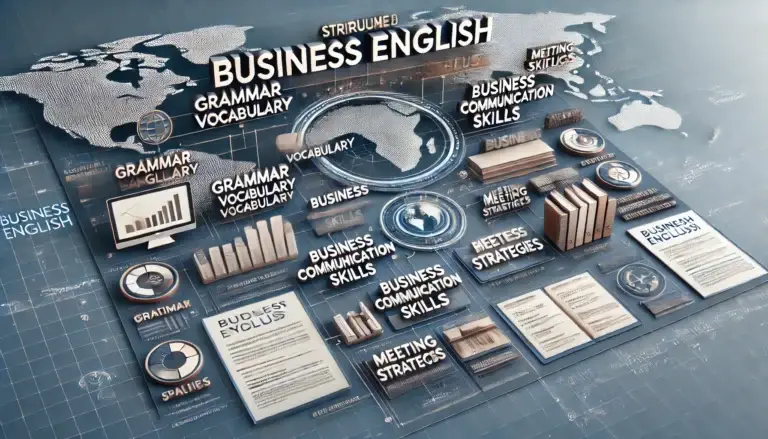10 Steps to an Effective Business English Syllabus
business english syllabus is such a delightful roadmap for learners eager to thrive in professional contexts, don’t you think? As a warm and caring instructor, I always encourage my students to see each lesson as a step toward real-world proficiency. In this gentle guide, we’ll explore ten essential steps that can help you design a truly effective program—one that boosts confidence, clarity, and connection. When we lay out a well-organized plan, our students flourish and discover new ways to express themselves with ease in every business situation.
Step 1: Begin with Clear Objectives
A well-structured business english syllabus needs clear goals. Outline what you want your learners to accomplish by the end of the course. These objectives could range from improving email-writing etiquette to mastering negotiation techniques. By defining measurable targets, you create a sense of direction and purpose, ensuring everyone is on the same path.
Step 2: Organize Content by Topic
Group lessons around specific business themes, such as presentations, phone etiquette, or handling conflict in a meeting. This approach not only keeps learners motivated but also helps them see the real-world value of each lesson, guiding them seamlessly into a corporate english outline.
Step 3: Integrate Real-World Scenarios
Try weaving real-life situations into your curriculum. Role-plays, case studies, and group discussions can recreate the challenges students might face in professional settings, making your business english syllabus more engaging and relevant.
Step 4: Focus on Core Language Skills
It’s easy to focus heavily on speaking skills, but don’t forget the importance of reading, writing, and listening. Well-rounded practice across all language skills is the backbone of any professional language framework, helping learners communicate effectively in a variety of contexts.
Step 5: Incorporate Progressive Difficulty
As you move through the lessons, steadily increase the difficulty level. This ensures constant growth. For instance, you might begin with basic phone conversations, then advance to complex negotiations—a hallmark of an advanced business curriculum. It’s all about building upon foundational skills for lasting success.
Step 6: Encourage Peer Collaboration
Group activities, pair work, and peer feedback sessions foster a supportive classroom environment. When students learn from one another, they also develop team-based problem-solving abilities, which are critical in any workplace.
Step 7: Utilize Authentic Resources
Incorporate business-related articles, podcasts, and videos. By engaging with current and authentic materials, students become more comfortable with the language and context they’ll encounter in real corporate environments.
Step 8: Build Vocabulary with Care
Don’t limit learning to straightforward word lists. Make vocabulary come alive by exploring relevant phrases and expressions. If you’d like to expand your repertoire of idiomatic expressions, try checking out 20 Business English Phrasal Verbs You Must Know. This resource can help learners dive deeper into the language they’ll actually use in the office.
Step 9: Assess Progress Regularly
Regular quizzes and self-assessments help learners see how far they’ve come. Provide constructive feedback, and celebrate small wins to encourage continual improvement.
Step 10: Adapt and Evolve
Finally, remember that a business english syllabus should be flexible. Stay tuned to changing industry trends and adapt lessons accordingly. If your field places a new emphasis on virtual communication, incorporate relevant language practice to keep everyone ahead of the curve.
By following these ten steps, you’ll create a structured, engaging, and practical framework that caters to diverse learning styles. Whether you’re introducing a corporate english outline, establishing a professional language framework, or rolling out an advanced business curriculum twice over, each choice you make can empower students to use English with confidence in the workplace. And as a kindhearted guide, I’m certain you’ll nurture your learners every step of the way.
Table of Contents
Laying Out a Corporate English Outline for Better Outcomes
When developing a new business english syllabus, I always like to think of it as drawing a map that guides learners from one milestone to the next. Each element of the plan builds upon the last, ensuring that students acquire language skills that are both practical and engaging. In this segment, I’d love to share a few gentle suggestions on how to lay out your corporate english outline in a way that maximizes results for both instructors and participants.
First, we should remember that a business english syllabus can look very different depending on the needs of the learners. For instance, if your team works in human resources, you’ll likely focus on recruitment vocabulary and conflict resolution techniques. But if you’re training a group of sales professionals, you might emphasize persuasive language and negotiation tactics. Tailoring the curriculum to specific objectives makes it easier for participants to stay motivated and see real-world benefits from each lesson.
Of course, any successful business english syllabus should devote special attention to english for meetings. After all, meetings are where major decisions take place, and using clear, confident language can make a world of difference. A structured approach to meeting-related tasks—such as writing agendas, clarifying discussion points, and offering constructive feedback—encourages smoother communication throughout the organization.
Additionally, don’t forget the importance of a strong workplace communication plan. By weaving speaking, listening, reading, and writing exercises into a single cohesive approach, you’ll help learners become adept in handling everyday interactions. Whether it’s composing an email to a colleague or delivering a presentation to upper management, covering these various modalities ensures your students develop well-rounded skills.
If you need more specialized resources, you might explore the Best Business English Dictionary: Top 5 Online Resources. This wonderful collection of dictionaries can offer in-depth explanations of business terminology, making it easier for learners to pick up new vocabulary. Coupling dictionary resources with real-life practice is an excellent way to keep lessons interactive and relevant.
While designing your corporate english outline, also think about the tools you use to assess progress. Regular quizzes, group activities, and peer reviews allow learners to build confidence step by step. You could even set up mini-workshops or weekly chat sessions that focus on applying new expressions or clarifying grammar points in an authentic setting. That way, your business english syllabus remains focused on practical outcomes, rather than just theory.
For a more modern touch, consider online platforms or blended-learning environments. Virtual forums, video conferencing, and digital assignments are particularly helpful in today’s flexible work climate. Incorporating technology can enhance collaboration, allowing participants to connect and support each other, even if they work in different departments or time zones.
Finally, I’d encourage you to look into Corporate English Training in 2025 | Boost Workplace Communication. Sometimes, partnering with specialized training providers can alleviate much of the administrative load, leaving you free to focus on lesson quality and learner engagement.
As you can see, laying out a business english syllabus that truly meets the demands of the modern workplace isn’t a one-size-fits-all task. Still, by highlighting english for meetings, building a strong workplace communication plan, and structuring a thoughtful corporate english outline, you’ll give learners the tools they need to excel in professional settings. With a little patience, creativity, and nurturing guidance, they’ll quickly gain the confidence to communicate effectively at every turn.

Crafting a Professional Language Framework for Your business english syllabus
Designing a business english syllabus can feel like weaving a tapestry—each thread of vocabulary, grammar, and real-world application comes together to form a beautiful pattern. When it comes to ensuring that every stitch is in place, a professional language framework is your guiding blueprint. By focusing on clear objectives, structured lessons, and realistic communication tasks, you’ll empower students to develop the fluency and confidence they need in today’s global workplace.
First, consider the broad goals you wish to achieve with your business english syllabus. Do your learners need to handle client negotiations? Are they expected to participate in english for meetings or present at international conferences? Once you’ve identified these real-life requirements, you can align them with specific teaching points. A well-crafted framework also helps learners see the bigger picture: they won’t just be memorizing vocabulary, but actively applying it in a meaningful context.
One of the pillars of a professional language framework is the integration of speaking, listening, reading, and writing skills. This balanced approach ensures that students can thrive in a range of professional settings, from drafting emails to speaking confidently during phone calls or teleconferences. Alongside these core skills, try introducing specialized modules focused on an advanced business curriculum. Such modules might delve into strategic thinking, leadership communication, and cross-cultural business etiquette—giving students an extra edge in their career growth.
While structuring your lessons, you may find it helpful to use case studies or simulations that mirror real-world workplace interactions. These practical exercises can be invaluable for developing teamwork, critical thinking, and problem-solving abilities. For instance, consider role-playing a company crisis scenario to practice conflict resolution. By connecting lessons to real challenges, you make the learning journey truly authentic.
Don’t be afraid to seek external resources to enhance your business english syllabus. For instance, if you want to expose students to more interactive exercises, try incorporating dialogues that mimic real-life interactions. One excellent resource is the Top 7 Business English Dialogues for Real-Life Scenarios. This collection can give your learners the opportunity to immerse themselves in authentic exchanges, improving their listening and speaking skills in a dynamic way.
Another key component is regular feedback. Gentle yet constructive guidance can encourage learners to identify areas of improvement and celebrate their progress. Whether it’s through one-on-one consultations, peer reviews, or self-assessment tools, consistent feedback helps students remain motivated. They’ll be better equipped to refine their speaking tone, expand their vocabulary, and perfect those subtle nuances of professional communication.
In the long run, having an advanced business curriculum that addresses industry-specific needs will prove highly beneficial. Even tasks like drafting proposals, creating persuasive presentations, and networking across cultural boundaries can be woven into your lessons. By gradually introducing more complex and specialized activities, you allow learners to stretch their abilities in a supportive environment.
Finally, never forget that your business english syllabus is a living document—it should evolve over time. As industries change and new technologies emerge, continue refining your approach to remain relevant and effective. The world of business moves quickly, and your teaching methods should adapt just as swiftly. In doing so, you’ll ensure that your professional language framework remains fresh, engaging, and perfectly tailored to the ever-shifting demands of the modern workplace.
Designing an Advanced Business Curriculum That Engages Learners
When we talk about an advanced business curriculum, we’re often discussing the pinnacle of professional language training. It’s that sweet spot where learners already have a firm foundation and are eager to refine their skills even further. As a caring teacher, it’s my joy to guide students through new challenges, whether that involves negotiating high-stakes deals or delivering persuasive presentations. Yet, no matter how sophisticated our lessons become, integrating a business english syllabus at this level ensures that students continue to develop the practical tools they need for real-world success.
To start, it’s helpful to anchor your curriculum with a clear workplace communication plan. This plan outlines the main objectives of each lesson, such as mastering leadership language, understanding complex financial terms, or developing strategies for crisis management. By setting these goals, you help learners see the real-world relevance of every activity, inspiring them to stay engaged and motivated throughout the course.
Alongside targeted objectives, it’s equally important to build upon a solid professional language framework. This framework may incorporate role-plays, case studies, and discussions of industry-specific trends. For instance, if your learners work in tech, you might focus on product pitches and investor relations. In a marketing setting, you could highlight brand positioning and campaign analysis. As you expand the curriculum, don’t hesitate to blend elements of a corporate english outline to ensure that all lessons remain business-focused and aligned with common corporate tasks.
Of course, words matter—a lot. Continually adding specialized vocabulary can make a remarkable difference in the learners’ overall competence. You may find it useful to supplement lessons with resources like the 10 Advanced Business English Vocabulary Words to Know. By exposing students to higher-level terms, you’ll help them communicate with greater nuance and clarity in fast-paced professional environments.
While designing your business english syllabus, try to keep a keen eye on interactive learning experiences. Group projects, debates, and peer evaluations allow students to put newfound vocabulary and strategies into practice. Additionally, consider hosting guest speakers or organizing virtual visits from experienced professionals. Hearing real-life success stories can motivate learners to see the bigger picture, encouraging them to become enthusiastic problem-solvers rather than passive participants.
Another valuable strategy is to weave in cultural awareness. Because many organizations now operate on a global scale, it’s crucial for students to recognize the subtle differences in business etiquette across regions. Encouraging them to explore these nuances fosters empathy and adaptability, two qualities that can enrich any collaborative project or negotiation.
To tie everything together, evaluate student progress through a variety of assessments—formal tests, group presentations, and reflective writing assignments. This approach allows learners to demonstrate growth in multiple ways, painting a fuller picture of their developing mastery. You can then modify your workplace communication plan to address any lingering skill gaps.
Finally, by weaving these elements seamlessly into your business english syllabus, you can ensure that advanced learners continue to thrive. Show them how they can use this advanced skill set to climb the career ladder, forge international partnerships, or launch exciting ventures. Point them to fascinating resources like Business English for broader context and further exploration. By linking each assignment and discussion back to concrete advantages in the workplace, you’ll keep learners fully engaged in your business english syllabus at every turn. In essence, an advanced business curriculum merges high-level communication objectives with a structured corporate english outline and a professional language framework, keeping each lesson relevant and purposeful.

Integrating English for Meetings: Effective Communication Strategies
Whenever I design a business english syllabus, I pay special attention to english for meetings. Meetings, after all, are the heartbeat of corporate life. They’re where colleagues brainstorm solutions, negotiate contracts, and make pivotal decisions. By weaving tailored speaking and listening practice into your lessons, you can help learners feel more at ease when voicing opinions, clarifying objectives, or even debating new ideas with colleagues and clients.
First and foremost, it’s crucial to structure meeting-focused sessions around real-world scenarios. For instance, you might simulate a project kickoff meeting or a budget review discussion so that students become familiar with common phrases and etiquette. This approach can fit seamlessly into your workplace communication plan, ensuring that learners pick up both industry-relevant vocabulary and key soft skills like active listening and polite interruptions.
It’s also beneficial to consider the level of the learners. For those in an advanced business curriculum, you can introduce more complex language tasks, such as leading a virtual meeting or managing cross-cultural communication. Here, students would practice not just simple turn-taking, but also persuasive techniques and diplomatic phrasing. Over time, they’ll feel confident enough to handle any business gathering, whether it’s a routine check-in or an international conference.
Another effective strategy is to encourage learner involvement in planning meeting agendas. Assign them roles—like chairperson or note-taker—and have them rotate through these responsibilities. This helps them get a sense of accountability and learn exactly how to prepare for, lead, and follow up on professional gatherings. By weaving these tasks into the business english syllabus, you’re directly connecting language acquisition to workplace realities, which can make lessons more tangible and engaging.
Never underestimate the power of feedback. A gentle correction here and a supportive comment there can go a long way. If a student mispronounces a key term, correct them kindly but promptly. If their grammar falters under pressure, offer quick reminders so that they can self-correct. Over time, this nurtures a self-awareness that enhances their overall communication style.
For learners who need extra help bridging the gap between theory and practice, consider combining face-to-face sessions with online tools. Video conferencing platforms, for instance, let students practice their english for meetings skills in a setting that closely mirrors virtual workplace interactions. You might also recommend resources such as the How to Improve Business English: 5 Practical Steps guide. This can be an excellent supplementary material, offering thoughtful tips on building vocabulary, refining pronunciation, and boosting confidence.
When you integrate meeting skills into your business english syllabus, it’s helpful to align them with your overall workplace communication plan. Let’s say your curriculum covers email etiquette and presentation skills; your meeting modules would naturally reinforce similar vocabulary and expressions. This cross-training approach ensures that students see the interconnectedness of various communication contexts, from drafting proposals to speaking on conference calls.
In essence, honing english for meetings is an essential ingredient in any successful program, whether it’s an introductory course or part of an advanced business curriculum. By practicing meeting-specific dialogues, role-plays, and collaborative activities, learners will see how each skill ties back to practical workplace tasks. And as they integrate these strategies consistently, their confidence grows, helping them shine as effective communicators in every corporate setting. Most importantly, they’ll come to realize that a thoughtfully crafted business english syllabus is their ultimate road map toward clear, engaging, and successful conversations in the professional world.
Implementing a Workplace Communication Plan to Boost Team Collaboration
A clear and well-structured workplace communication plan can be the cornerstone of a successful business environment. When everyone knows how to express ideas, provide feedback, and resolve conflicts effectively, you’re likely to see remarkable growth in productivity and team morale. From my perspective as a patient and caring educator, the key is to weave this plan seamlessly into your existing business english syllabus, ensuring that every lesson aligns with real-world objectives.
One effective way to integrate your communication strategy is by establishing a corporate english outline that details the topics to be covered. For example, you might include modules on email etiquette, cross-cultural communication, and negotiation techniques. By having a clear outline, you offer learners a structured roadmap, making it easier for them to understand how each lesson builds on the last. This roadmap also helps highlight the importance of consistent language use across different channels—whether it’s face-to-face discussions or digital platforms.
In tandem with a strong outline, it’s crucial to develop a professional language framework. This framework goes beyond standard grammar exercises by focusing on functional language, tone, and style. For instance, students might learn how to politely disagree in a meeting, resolve misunderstandings, or provide constructive feedback without causing offense. Such skills are invaluable in the workplace, as they foster an atmosphere of respect and collaboration.
When you combine a business english syllabus with a robust workplace communication plan, you should also consider adding specialized lessons. Here’s where an advanced business curriculum can truly enhance the learner experience. By diving into more complex communication tasks—like crisis management, leadership communication, or persuasive presentations—you give students the opportunity to refine higher-level language skills. These advanced modules empower them to tackle real challenges that may arise in dynamic professional settings.
Additionally, don’t forget the value of role-plays and simulations. They can serve as the glue that holds all the theoretical elements together. Whether it’s practicing a tense boardroom conversation or resolving a conflict between team members, these activities make learning come alive. They also let students experiment with different linguistic techniques, building confidence in a safe, supportive environment.
Feedback loops play a central role as well. Offer frequent, constructive critique on everything from pronunciation to email formatting. Encourage peer evaluations, too—sometimes a fellow learner can provide insights that an instructor might overlook. This dual approach helps learners see their progress through multiple lenses, reinforcing key lessons along the way.
Moreover, keep an eye on technology. With so many teams now collaborating virtually, digital communication tools—like video conferencing or instant messaging—are part of everyday work life. Your business english syllabus could incorporate guidelines on how to maintain professionalism in these online spaces. Emphasize the nuances of tone and clarity in written messages, especially in settings where misunderstandings can easily arise.
As you watch your students grow, you’ll likely notice how an integrated workplace communication plan with a corporate english outline and a professional language framework can genuinely transform their confidence levels. You’ll see them connecting with colleagues more effectively, solving problems with greater ease, and stepping into leadership roles without hesitation. Through consistent practice and careful guidance, your classroom can become a powerful catalyst for genuine collaboration—a place where language learning directly influences workplace success. And, in the end, that’s what an effective business english syllabus should aim to achieve: real, positive impact on people’s professional lives.
Driving Ongoing Success with a Comprehensive business english syllabus
A truly comprehensive business english syllabus does more than just teach words and phrases—it creates a pathway for long-term growth and progress. When courses are structured in a forward-thinking way, learners don’t simply memorize language rules; they develop critical communication skills that evolve with their careers. As a supportive teacher, I believe the key to ongoing success lies in continual reinforcement, guided practice, and flexible adaptation.
For instance, if you’ve emphasized english for meetings throughout your curriculum, encourage students to keep building on those skills. They might lead a new project kickoff session or take charge of an internal discussion about future initiatives. When they see themselves mastering real-life tasks, their motivation soars. Over time, this sense of accomplishment will help them engage even more deeply with each component of your business english syllabus.
It’s also a good idea to maintain a workplace communication plan that adapts alongside any organizational or industry shifts. Language learning isn’t static, especially in fast-paced work environments where new technology and global markets can reshape expectations overnight. A well-rounded plan will highlight crucial communication tasks—like proposing innovative strategies or collaborating with remote teams—and show learners exactly how to apply their language skills in these contexts. This not only boosts individual confidence but also strengthens the team as a whole.
In this journey toward continuous improvement, it can be incredibly helpful to have consistent checkpoints. Regular performance reviews and feedback sessions offer learners the chance to reflect on their progress and identify areas for growth. This is especially beneficial when you consider the variety of language tasks in a modern business setting, from formal presentations to virtual networking. By assessing performance at multiple stages, you ensure that the business english syllabus remains relevant and responsive to changing needs.
Should you find that you need extra support or additional resources, always remember that there are professionals dedicated to helping you refine your content. If you ever want to explore collaborations, feel free to Contact Us for more insights and personalized guidance. Our Blog Title: 10 Steps to an Effective Business English Syllabus highlights plenty of practical tips and creative ideas to keep you inspired along the way.
Above all, keep nurturing your learners with patience and positivity. Language acquisition thrives in an environment where mistakes are seen as stepping stones to success. Gently correct errors, applaud achievements, and remind students that progress often comes in small but steady increments. When your classes focus on real-world applications, from writing professional emails to negotiating with confidence, learners are far more likely to carry those skills forward in their careers.
In short, a comprehensive business english syllabus is a living, breathing framework—one that evolves with your students and adapts to the ever-changing landscape of the business world. By pairing clear objectives with ongoing practice, flexible lesson design, and a supportive classroom environment, you’ll empower learners to excel not just in English, but in all facets of their professional journey. This unwavering commitment to growth and adaptability is what truly drives ongoing success.
Related Posts

Top 10 Corporate Idioms to Sound Professional
Discover corporate idioms that make you sound natural and professional in business communication.

What Is the Main Purpose of Business English
Understand the main purpose of business english and how it supports global communication and careers.

8 Office Vocabulary Words You Need to Know
Learn essential office vocabulary to communicate clearly in emails, meetings, and daily workplace tasks.




